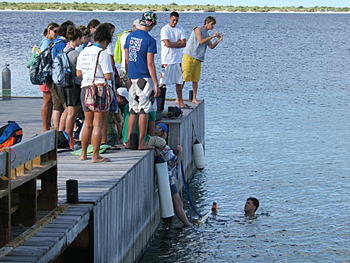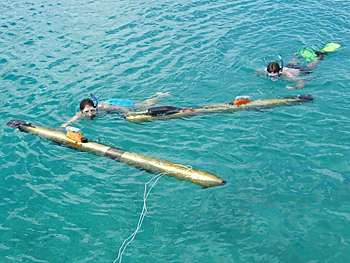
Located about 50 miles off the coast of Venezuela, Bonaire's reefs have been legally protected since 1979 and are generally much healthier than others in the region. The scientists, who want to know why that's the case, are using the robots known to the scientific community as autonomous underwater vehicles (AUVs) because they can provide more data than ever obtained by the scientists.
That's in large part due to the AUVs' ability to operate in places and conditions where other research vessels cannot. Scientists don't even need a large ship to use AUVs; they can deploy the AUVs from the shore. Once submerged, the robots can get closer to features on the seafloor without disturbing them. Given their flexibility, AUVs are seen as the new frontier in oceanography, and this collaboration is thought to be the first of its kind.
“This expedition is to our knowledge the first time anyone has tried to bring this many AUVs together in an exploration field project,” said Art Trembanis, assistant professor of geological sciences at UD, who is part of the month-long expedition known as “Bonaire: Exploring Coral Reef Sustainability with New Technologies.”
Researchers from organizations including UD's College of Marine and Earth Studies (CMES); the Virginia Institute of Marine Science (VIMS); the Scripps Institution of Oceanography; the National Oceanography Centre, Southampton; and the University of British Columbia also are involved. Additional technical support has come from the participation of commercial industry groups such as GeoAcoustics Ltd. and Hafmynd Ehf, of the United Kingdom and Iceland respectively.
The robots on this expedition can take pictures with both light and sound and gather information on salinity, temperature, oxygen levels and other water quality parameters. They also take underwater video and have side scan sonar capabilities, which means the robots can emit sounds and create an image based on the echoes created when the sounds bounce off of objects and the sea floor.
The scientists are looking to the robots to help them map Bonaire's reefs and are hoping the AUVs can help identify any new species they come across as they explore the depths. The robots also help the team better plan scuba diving missions by surveying the waters before dives take place.
“The three vehicle operations this month have been extremely productive, with the robots combining for nearly 100 hours of dive time, during which they have amassed over 50 kilometers of reef mapping from as shallow as 10 feet to depths of more than 700 feet, well beyond that which divers can safely and effectively operate and into areas seldom if ever explored in these or other coral reef settings.”
The expedition's AUVs are the Fetch1, developed by Mark Patterson, associate professor of marine science at VIMS, and two Gavias, created by Hafmynd Ehf. One of the Gavias is owned and operated by the University of British Columbia. The other is operated by Hafmynd, but UD researchers have a unique interest in this robot: Later this year, the University will acquire the Hafmynd vehicle.

“We're keen to improve our understanding and our skills with this new platform by learning what [the different modules] are capable of,” Trembanis said.
He noted that the trip has been useful for him, but also for the 16 undergraduate study abroad students on the trip who are interacting with the technology.
“For our students here participating in the Bonaire winter '08 study abroad, having access to the robots provides a unique once-in-a-lifetime opportunity, and the students have been eager and helpful participants in various aspects of the science project,” he said.
Check the College of Marine and Earth Studies Web site at [www.ocean.udel.edu] this spring, when UD's new AUV is scheduled to be delivered, for more details on the University's involvement with this revolutionary technology.
For more on AUVs and for detailed coverage of the Bonaire expedition, which is funded by the National Oceanic and Atmospheric Administration (NOAA), visit NOAA's Ocean Explorer Web site at [http://oceanexplorer.noaa.gov/explorations/08bonaire/welcome.html].
Article by Elizabeth Boyle

